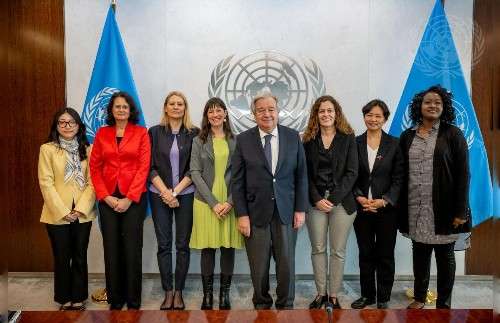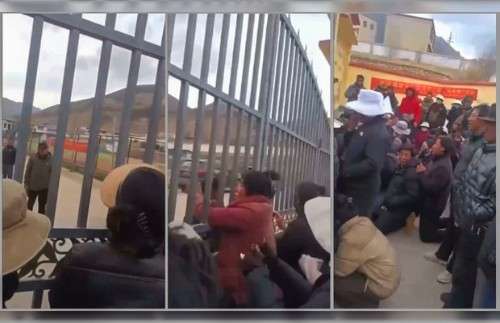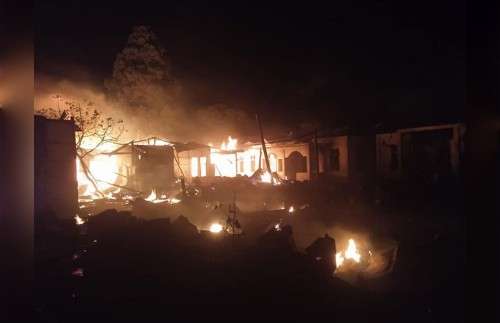By Saron Messembe Obia

Mental health is a crucial factor for criminal investigations and understanding adolescents deviant behaviour in the academic milieu. Cultural civilization is another aspect which challenging not only to African youths but also to Europeans. The World Health Organizations (WHO) deduce a metal healthy person as; one who is able to establish a harmonious relationship with his community, participate as well as prone for sustainable development (Pilgrim, 2005). The National Institute of Mental Health Epidemiological Catchment Area (NIMH- ECA) identified four major adult health disorders which develop from adolescent; Anxiety, Major depression, Drug dependence and abuse and alcohol dependence and abuse (Callicutt, 1997). Mental health of youths is strategic in the evaluation of juvenile delinquency in the academic milieu, amongst peers and family (Atkinson & Hornby, 2002).
During the past decade, crime scheme keeps increasing in a geometric rate within the academic milieu, students as well as teachers are been victimized. This social exacerbation or adolescent misconduct is related but not limited to: illicit drugs smuggling and substance abuse, weapons brought to school, bullying, non-respect of educational norms, and challenging school authorities (Masitsa, 2008: 236 – 237). For example, the knife carrying culture in the United Kingdom, of adolescent delinquents has caused more injuries and deaths than gunshot incidents (2008: 39). Where as in South Korea, youths are engaged in cigarette smoking, alcohol abuse, linking it to the new economic cancer ‘cyber-crime’, which pose a serious challenge to the deeply conservative nation (Kim & Kim, 2008: 1– 15).
Juvenile Delinquency scope
Juvenile delinquency is a pattern of behaviour exposed by an individual (youth) below the age of eighteen that is contrary to societal norms and culture of a given territory. It usually linked environmental deprivation, domestic violence or psychiatric difficulties in the child (Benjamine Fine, 1995). A research conducted by Rossouw (2003: 416) on Learner discipline in South African public schools revealed the following causes of delinquency within schools: Lack of transformation, Lack of counselling services, Intolerance of school management towards some groups, Parental apathy, Corruption, and Bribery. He equally exposed the incompetency in some academic milieus, with teachers been the internal cause of learner misconduct, due to poor qualification and inadequate expertise, which prone misconduct, and harbour work-to-rule attitudes.
Causes of juvenile delinquency
Cindi (2006: 40) defines a community as a social group that shares common geographical boundaries, values and interests. The concept is often used interchangeably with “society” and will be used in this manner in this review. The expression, “children are a mirror of their community”, aptly describes the correlation between juvenile misconduct and antisocial behaviour exemplified in the individual’s community
Factors such as over-population, high density housing, ethnic or cultural composition, especially in the most developed countries, are often cited as criminogenic. Prinsloo’s (2007: 155–163) assertion – that modern materialism is one of the critical sources of societal moral decay which impact on adolescent behaviour, is an apt observation. This phenomenon causes the individual to be obsessed with self-enrichment and personal gratification, thus causing him/her to be at risk of offending. When the community exemplifies antisocial behaviour such as binge drinking, sexual immorality, violence, theft, lying and cheating, children and youth emulate them. According to Steyn (2008: 213), drug trafficking, high unemployment rates, social isolation, poor infrastructure and little institutional support, are also precursors of juvenile misconduct.
The family environment
One of the major factors which out pin juvenile delinquency in contemporary times is the family environment, which is considered as prerequisite for youth misconduct (Sanni et al (2010: 21- 27). Some scholars out pin social institution as the most important cause of delinquency (Loeber, Farrington & Petechuk, 2003: 8; Ernest, 2003: 2) with the characteristics of dysfunctional as a model for adolescent antisocial behaviour.

Broken homes or marriages are social factors which lead to dysfunctional family structures. When children witness parental relationships deteriorate delinquency is likely to emerge, as some will engage in illicit drug, risky sexual behaviour (prostitution), street cultures fighting and violent basic weapons, theft to survive harsh street conditions. (Horne, 2004: 331-334; Horne 2001: 5-3, Tyler et al, 2001: 151). All this issues emerge from parental divorce and step-parent families, which leads to low self-control to some adolescents causing instability and stress among, leading to misconduct (Ernest, 2003: 74, Upchurch et al, 1999: 920-922).
Poor academic performance
Education is a fundamentally human right necessary for any teenager or person inscribed in nearly all constitutions in the world. Academic performance is a major aspect in child, development, as those that perform poorly tend to adhere to deviant behaviour such as alcohol consumption, illicit drugs, fighting and cybercrime expressing feelings of frustration (Crosnoe, 2006: 57-58; De Wet, 2003: 92-97). Some teachers are the cause of misconduct and juvenile delinquency in schools. Some teachers arrive the school late, deviant dressing, and some request for students help financially. As such, frustrated students lose interest in their studies, turn to delinquent behaviour such as truancy and violence.
Gang, low self-control or Peer influence
Snack bar restaurants and night clubs are the leading activities in developing countries, adjacent to schools which open doors for gangs and prostitutes leading to an increase delinquency (De Wet, 2003: 92-93). As such, cybercriminals and illicit drug dealers operate gangs which expand in the academic milieu. The dynamics have changed with increasing terrorizing and even stabbing teachers and students that condemn this antisocial scheme. The menace on students and teachers may lead to truancy and absenteeism, respectively, thus poor academic performance.
Certain deviant behaviour is linked to low self-control or peer influence. For instance, girls that usually engage in drinking, smoking, sexual promiscuity and disobey parents is as a result of peer influence (Flannery, Williams & Vazsonyi, 1999: 248-252). Adolescents engage in vandalizing school property in order to gain recognition amongst peers or gangs (De Wet, 2004: 92). These peer groups usually engage in theft, rape, and sale of drugs like marijuana in order to commit other delinquent acts. Nonetheless, it’s inappropriate to discuss the above aspect without mentioning that peer group influence is the major component in the escalation of delinquency.
Policing antisocial behavior (juvenile delinquence) in the academic milieu
Education is increasing been threaten by juvenile delinquents, who engage in several antisocial behaviours such as smuggling of weapons (knife, blade, guns), illicit drug (marijuana) consummation within the campus, rape, cybercrime and the creation of gangs. According to Haynie et al (2009), these antisocial behaviours emanate from adolescents exposure to violence, which affects them psychologically. These types of exposure are but not limited to; street culture, peer influence, school violence, murder, family and friend suicide. For example; In one incident in Madison, a learner was shot in the school hallway during class change (Stephens, 2010: 45). About 998 correspondents research related to juvenile delinquency which is related adolescent is linked to school marginalization, and low academic performance adhere to the subscription into gangs (Dishion et al, 2009). Below are some recommended measures in order to limit juvenile delinquency.
Smuggling of weapons and illicit drug
Following series of interviews with youths from different schools in Cameroon, there exist several ways of smuggling weapons into education premises. Razors are put in wallets or in the New Testament Bible in order to enter the campus. In case of a fight, the individual will simply remove his blade and attack his or her opponent, which might lead to a severe wound and even murder. As such, the disciplinary counsel while conducting a search of students must take the above aspects into consideration in order to avoid the increasing rate of murder in schools. The proliferation of bars and clubs around campuses in critical to academic performance, students sometimes scale the fence, remove their uniforms, start drinking in nearby snacks as well engage in smoking of cigarette and marijuana (commonly known in criminal milieu as banga, Jamaican jama jama, 32 spice just to name a few).
Cybercrime and gangs in schools
The increasing poles of gangs and youth involvement in cybercrime is linked to musical milieu and the emergence of information and communication technologies which helps in facilitating crimes in social networking sites. The social cleavage in some schools prompt the creation of gangs, which influence peers within the campus. Some denigrate their classmates dressing, shoes, and due to low self-control, they engage in cybercrime. In a research conducted by Abia et al (2010) on youths attraction in cybercrime in Cameroon; peer pressure, and the quest for fast wealth where evoked. In the same manner, inadequate training of law enforcement of officers in some sub Saharan African countries is another issue for the increasing nature of cybercrime and the creation of gangs which operate internationally.
The challenging issue in policing cybercrime and the emergence of gangs in academic milieu is corruption and poor parenting. Most parents will not accept their kids to be auditioned or disciplined when apprehended with others engaged in deviant behaviours like illicit drugs with other street children who are quickly jailed. Teachers are sometimes threatening by students whose parents are administrative authorities, as such breaching academic principles. There is also the need of counselors and educational psychologists to deal with the emerging nature of delinquency.
Teachers-parent relationship and technology
The globalization period has facilitated crimes as well as technology provided can be use in policing deviant behaviours and limiting juvenile delinquency in schools. With the evolution of social networking sites, teachers can easily submit report to parents of truancy and those engaged in antisocial behaviours. Each teacher creates a WhatsApp group, connects with parents of students, in case the child does not attend lectures and submit assignments his parents are immediately informed via WhatsApp. After each test, the scores are sent to the parent in case the child modifies or do not present the exam paper the parent will know the kid’s attitude and how to guide him.
Shaw and Mckay’s Social Disorganisation Theory asserts crime as a result of social disorganisation in which the environment impacts an individual negatively. When the environment fails to provide positive socialisation in instances of extreme poverty, homelessness, deviant peer and community culture, individuals resort to crime (Hagan, 2012: 165). Poor and inadequate implementation of prevention programmes; lack of administrative reform programmes; the increasing youth population; and the concurrent rise in social challenges such as poverty, unemployment, prostitution with undesirable illnesses like HIV/AIDS and teenage pregnancy are consequences of juvenile delinquency.
Juvenile delinquency is global menace and if not well policed might have a shift in to the new world order terrorist activities. The various consequences of juvenile delinquency on the individual, victim, family and community, are not to be ignored by any country. All the issues discussed above are some but not all the factors which exacerbate antisocial behaviour within schools. Nonetheless a task force is necessary to coordinate teacher-parent relationship in matters related to juvenile delinquency of the children and as well assure that educational psychologists are available in every schools.
References
Atkinson, M & Hornby, G 2002. Mental health handbook for schools. London: Routlege Falmer.
A study of juvenile delinquency amongst adolescents in secondary schools in Gauteng by Margaret Priscilla Ntshangase. Master of Education, University of South Africa, November 2015.
Benjamine Fine. One Million Delinquents (Cleveland, 1995) P.31
Callicutt, J.W 1997. Overview of the mental health. In Watkins, T.R & Callicutt, J.W (eds.). Mental health: Policy and Practice Today. California: Sage Publications Inc.
Cindi, M. L. 2006. Factors that predispose children to be in conflict with the law in the Ekurhuleni Metropolitan Municipality: a health perspective. Master of Arts. Pretoria: Unisa.
Crosnoe, R. 2006. The connection between academic failure and adolescent drinking in secondary schools. Sociology of Education 79 : 44 – 60.
De Wet, C. 2003. Eastern Cape educators’ perceptions of the causes and the scope of school violence. Acta Criminologica, 16 (3): 89-106.
De Wet, C. 2004. The extent and causes of learner vandalism at schools. South African Journal of Education. EASA. 24 (3): 206 – 211.
Dishion, T.I, Veronneau, M.H, & Myres, M.W (2010). Cascading peer dynamics underlying the progression from problem behaviour to violence in early to late adolescence. Development and Psychopathology, 22, 603- 619.
Ernest, M.Z. 2003. The effects of divorce in a South African community with special reference to Esikhawini in KwaZulu-Natal. Masters. University of Zululand.
Flannery, D.J, Williams, L.L & Vazsonyi, A.T. 1999. Who are they with and what are they doing? Delinquent behaviour, substance use, and early adolescence after school time. American Journal of Orthopsychiatry, 69 (2): 247-253.
Grennan, Mary Ita, “The Role of the School in the Prevention of Juvenile Delinquency ” (1957). Master’s Theses. 1393.
Hagan, F.E. 2012. Introduction to criminology: theories, methods and criminal behaviour. (8th ed). Mercyhurst College: Sage Publications.
Haynie, D.L. 2001. Delinquent peers revisited: does network structure matter? American Journal of Sociology, 106(4): 1013-1057).
Haynie, D.L, Petts, R.J, Maimon, D, & Piquero, A.R (2009). Exposure to violence in adolescence and precocious role exits. Journal Of Youth Adolescence, 38, 269- 286.
Horne, A. 2001. Brief communications from the edge: psychology with challenging adolescents. Journal of Child Psychotherapy, 27 (1): 3 -18.
Horne, A. 2004. “Gonnae no’ dae that!”: the internal and external worlds of the delinquent adolescent. Journal of Psychotherapy, 30. (3): 330 – 346.
Kim, H & Kim, H. 2008. Juvenile delinquency and youth crime. New York: Nova Science Publishers.
Loeber, R, Farrington, D.P & Petechuk, D. 2003. Child delinquency: early intervention and prevention. Child Delinquency Bulletin Series. US Department of Justice. Office of Justice Programs. Available from: 186162.pdf.
Masitsa, M.G. 2008. Discipline and disciplinary measures in the Free State township schools: unresolved problems. Acta Academia, 40 (3): 234 – 270.
Masitsa, M.G. 2011. Exploring safety in township secondary schools in the Free State province. South African Journal of Education, 31: 163-174.
Pilgrim, D 2005. Key concepts in mental health. London: Sage Publications Ltd.
Prinsloo, E. 2007. Implementation of Life Orientation programmes in the new curriculum in South African schools: perception of principals and Life Orientation teachers. South African Journal of Education, 27 (1): 155-170.
Rossouw, J.P. 2003. Learner discipline in South African public schools: a qualitative study. Koers, 68 (4): 413-435.
Sanni K.B, Udoh, N.A, Okediji, A.A, Modo, F.N & Ezeh, C.N. 2010. Family types and juvenile delinquency issues among secondary school teachers in AKWA Ibom State, Nigeria: counselling implications. Journal of Social Science, 23(1): 21- 23.
School Violence and Juvenile Delinquency in Malaysia: A Comparative Analysis between Western Perspectives and Islamic Perspectives by Zainab Mahirah Ismail & Nik Suryani Nik Abdul Rahman, Available online at www.sciencedirect.com
South Africa. Department of Education. 2008. Example of a code of conduct for a school. Pretoria: Department of Education. Available from: www.education.gov.za
South Africa. Statistics South Africa. 2012. Census 2011: Census in brief. Report No 03-01-41. Pretoria. Statistics South Africa. Available from:
South Africa. Department of Education. 2012. Report on the 2009/2010 annual surveys for ordinary schools. Pretoria: Department of Education.
Steyn, F. 2008. Lifeskills training for children with deviant behaviour: The Nouwpoort Youth Community Development Project. Acta Academica. 40 (2): 205 – 243.
Steyn, M, Badenhorst, J & Kamper, G. 2010. Our voice counts: adolescents’ views on their future in South Africa. South African Journal of Education. 30 (2): 169- 188.
Tyler, K.A, Hoyt, D.R, Whitbeck, L.B & Cauce, A.M. 2001. The impact of research on adolescence, Journal of Research on Adolescence 11 (2): 151-176.
Upchurch, D.M, Sucoff, C.A & Levy-Storms, L. 1999. Neighbourhood and family contexts of adolescent sexual activity. Journal of Marriage and the Family, 61: 920-933.
World Health Organisation (WHO). 2013. Available from
www.who.int/pmnch/media/news/2012/20120426_45_cpd/en/index.htm
World Youth Report. 2003. Report of the Secretary-General (official document: A/58/79 & E/CN.5/2003/4) pp189 – 211. Available from:
www.un.org/esa/socdev/unyin/documents/cho7.pdf
[The Author is the Editor of crimeandmoreworld.com]
Timor-Leste Seeks Economic Lifeline as Oil Wealth Dwindles
South Africa Prepares to End Lion Hunting in Captivity
UN Secretary-General Meets with Working Group on Discrimination Against Women and Girls
On Both US Coasts,Pro Palestinian Encampment Protesters Hold Ground
Philippine Police Arrest 3 Suspects Over On-Air Killing of Broadcaster
In Tibet, Parents Plead for Children to Help Collect Caterpillar Fungus
Vietnamese Monk Seeks Justice for Brother Who Died after Police Interrogation
Hamas Reviews Israeli Cease-Fire Plan in Gaza
Subscribe Our You Tube Channel
Fighting Fake News
Fighting Lies














